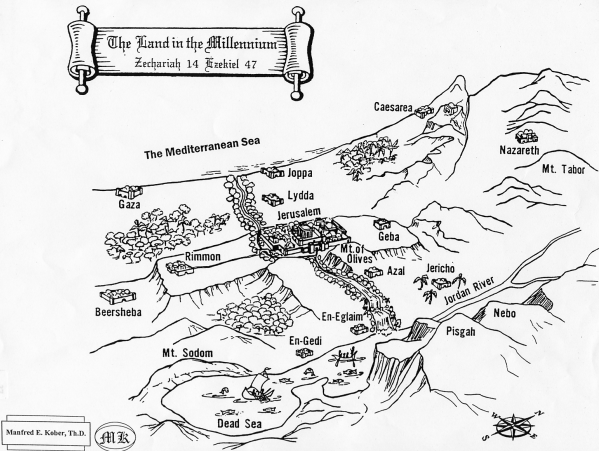
|
The Millennial River (Ezekiel 47) |
A key test for whether a person interprets the prophetic Word literally is the river that is described in Ezekiel 47 and in other places in the Old Testament. This amazing river will originate from the house of the LORD (compare Joel 3:18) as a very shallow stream. Gradually the stream will get deeper and fuller until it is over a man's head. It eventually travels east until it empties into the Dead Sea which will then be a terrible misnomer because the waters of the Dead Sea will be turned into fresh water teeming with fish (see Ezekiel 47:1-10). It will be the Living Sea!
In Zechariah 14:8 we learn that half of this river will empty into the Dead Sea and half of the river will empty into the Mediterranean Sea. This river is also mentioned in Psalm 46:4 (and notice the context in Psalm 46:9-10 which clearly speaks of the kingdom).
Manfred Kober has provided the following illustration of the future topography of the Holy Land showing this amazing river of life flowing into the two great seas:

The descriptions of this river are as literal as literal can be. There are clear geographical references made in connection with this river (Ezek. 47:8-10). There are exact distances and depths measured out (Ezek. 47:3-5). The details concerning this river are very descriptive: it flows into the sea (Dead Sea) and the waters become fresh which once was the saltiest body of water on earth. There will be many varieties of fish in a body of water where fish formerly could never live. Fishermen will stand beside it and there will be the spreading of nets. Are we to reject this whole description and spiritualize it and give it some strange meaning according to our own fancy, or should we take it at face value?
When people depart from a literal interpretation they deny the plain sense and they give the text some other sense according to their own lively imagination. It is almost humorous to read the commentaries and see how people spiritualize this river and make it mean whatever they want it to mean. Some say it refers to the "stream of church history." Others say it refers to going deeper in the Christian life ("ankle-deep Christians," etc.). Some think it refers to water baptism. Some say it refers to "vitality flowing forth from Holy Ground," etc. When all else fails, why don't we just let it say what it says? Does God really mean what He says or do we need to take what God says and force our own meaning upon it?
The river is directly connected to the house of the LORD (Ezek. 47:1-2; Joel 3:18), so if a person rejects the literalness of this river they must also reject the literalness of the temple which is described in Ezekiel chapters 40-48. Actually the three (the temple, the river and the animal sacrifices) must stand or fall together. See the study Do You Interpret the Bible Literally? Six Tests to See if You Do.
The following description of this amazing future river is provided by Manfred Kober (taken from Chapter 31 of the book, Basic Theology: Applied, Wesley & Elaine Willis and John & Janet Master (Victor Books, 1995), pages 287-290:
|
Alva McClain, whose work on the kingdom is classic, has written the following about the millennial river issuing from the temple:
In addition to these natural results which must follow properly controlled rainfall, there may also be streams continually flowing by miraculous causation, such as the marvelous stream pictured by Ezekiel (47:1-12). Its issue from the temple, its immense size, the beneficial qualities of its fruit, its perennial flow "in summer and in winter" (Zech. 14:8)--all emphasize the supernatural nature of the stream. There is nothing at all inherently impossible in such a phenomenon. Why should anyone stumble at the idea of a beautiful stream springing up at the geographical center of our Lord's blessed Kingdom on earth, with healing in both its waters and the fruit which grows beside it? Is there anything incredible here, if we remember that the coming King is the One who once turned water into wine and sent the sightless man to wash away his blindness in the waters of Siloam (John 9:11)? What a visible symbol this will be to remind the nations of the unfailing blessings which will flow from the throne of the Son of David! And from this shrine none will go away in heartbreaking disappointment because no help has been found [The Greatness of the Kingdom, p. 237].
| The Middletown Bible Church 349 East Street Middletown, CT 06457 (860) 346-0907 |
More articles under Prophecy
|